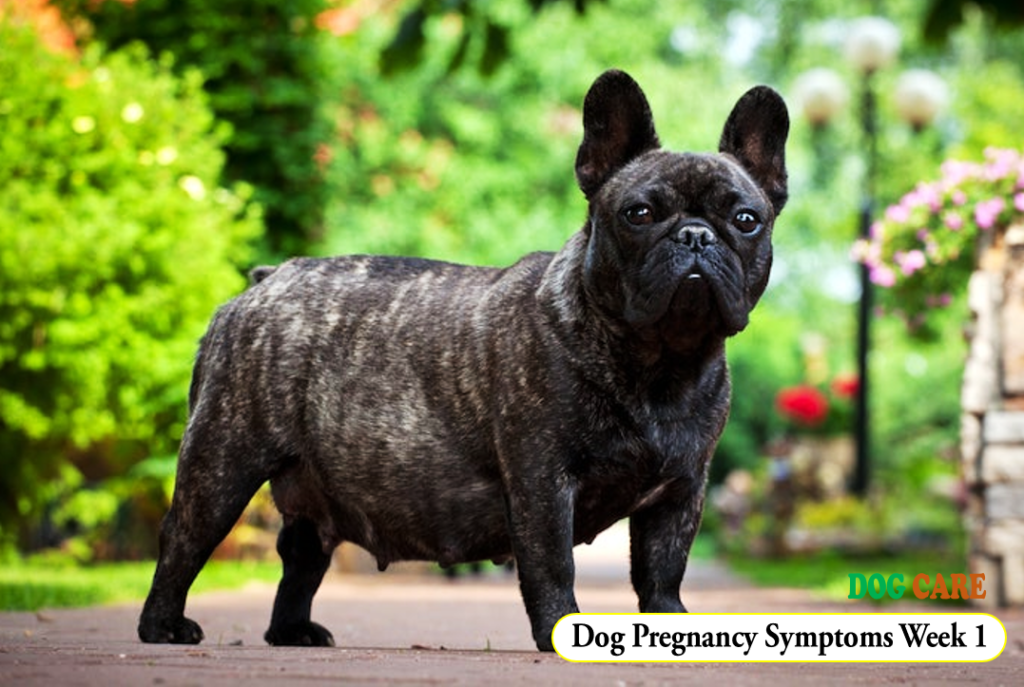Dog Pregnancy Symptoms Week 1 : During the first week of dog pregnancy, there are no specific symptoms observed. However, changes on a hormonal level occur as the fertilized egg implants into the uterine wall.
This usually happens around six to twelve days after mating. It is important to note that the first week is often difficult to detect in dogs. Both physical and behavioral changes may be subtle or non-existent during this early stage.
It is only after a couple of weeks that dog owners start noticing more noticeable signs of pregnancy such as changes in appetite, vomiting, or nipple enlargement. Regular monitoring by a veterinarian is vital to ensure the well-being of the pregnant dog and her upcoming litter.

2. Understanding The Pregnancy Timeline
Understanding the pregnancy timeline is crucial when it comes to dog pregnancy. It allows you to track the progress of your dog’s pregnancy and identify any potential issues along the way. In this section, we will delve into the details of the first week of dog pregnancy and discuss the significance of detecting pregnancy early.
2.1 The First Week Of Dog Pregnancy
The first week of dog pregnancy is often unnoticed as it is during this time that the fertilized egg implants itself into the uterus lining. It can take up to seven days for the fertilized egg to complete the journey from the oviducts to the uterus. Once implanted, the egg begins to develop and form an embryo.
During this early stage, it can be challenging to detect any physical signs of pregnancy. However, some dogs may exhibit subtle changes in behavior. They may become more affectionate, clingy, or show a decrease in appetite. These changes can be attributed to hormonal fluctuations that occur as a result of the pregnancy.
It’s important to note that physical changes and symptoms associated with dog pregnancy typically become more apparent as the pregnancy progresses. Therefore, it’s crucial to closely monitor your dog’s health and behavior throughout the entire pregnancy timeline.
2.2 Significance Of Detecting Pregnancy Early
Detecting pregnancy early in dogs holds great significance for their overall well-being. It allows you to provide necessary care and make appropriate adjustments to their lifestyle, nutrition, and exercise routine. The earlier you can confirm a pregnancy, the better prepared you can be to ensure the health and safety of both the mother and her future puppies.
Early detection of pregnancy is also crucial to identify and address any potential complications that may arise. For instance, early detection can help detect any signs of miscarriage, false pregnancy, or developmental abnormalities. It gives you a head start in seeking veterinary care and proper guidance to ensure a smooth and healthy pregnancy for your furry friend.
Furthermore, early detection of pregnancy enables you to make timely decisions regarding important matters such as prenatal vitamins, vaccinations, and preparing a suitable whelping area for the mother. By staying proactive and vigilant during the first week, you can set the stage for a successful and stress-free pregnancy journey.
3. Early Signs Of Dog Pregnancy
When your furry friend becomes pregnant, it’s an exciting time for both of you. While it might be too early to confirm the pregnancy, there are a few early signs that can give you an indication that your dog is expecting. By recognizing these symptoms early on, you can provide the necessary care and support for your pregnant dog. In this article, we will explore the three early signs of dog pregnancy: changes in behavior, changes in appetite, and nipple enlargement.
3.1 Changes In Behavior
One of the first signs of dog pregnancy is changes in behavior. Just like humans, dogs experience hormonal changes during pregnancy, which can affect their demeanor. As early as week one, you may notice your dog becoming more affectionate and seeking your attention. She may also exhibit nesting behavior, such as digging in the ground or rearranging her bedding. These behavioral changes are her way of preparing for the arrival of her puppies.
3.2 Changes In Appetite
Another early sign of dog pregnancy is changes in appetite. During the first week of pregnancy, you may notice that your dog’s appetite fluctuates. While some dogs may experience a decrease in appetite, others may have an increased desire to eat. It’s important to monitor your dog’s eating habits and ensure that she is getting a balanced diet to support her growing puppies.
3.3 Nipple Enlargement
Nipple enlargement is a physical change that can indicate pregnancy in dogs. As the pregnancy progresses, the hormone levels in your dog’s body increase, leading to the growth and darkening of her nipples. In week one of pregnancy, you may start to notice that your dog’s nipples are more prominent and enlarged compared to their usual size. This change is due to the preparation of the mammary glands for nursing the puppies.
Understanding the early signs of dog pregnancy is essential for providing the best care for your furry companion. By observing changes in behavior, appetite, and nipple enlargement, you can ensure a smooth and healthy pregnancy for your dog. Remember to consult with your veterinarian for proper guidance and support throughout this exciting journey.
4. Physical Changes In Week 1
During the first week of pregnancy, there are several physical changes that occur in a dog’s body. These changes are often subtle and may not be immediately noticeable. However, being aware of these changes can help you determine if your dog is pregnant and provide proper care. In this section, we will explore three common physical changes that occur in week 1 of dog pregnancy.
4.1 Vaginal Discharge
One of the first signs of pregnancy in dogs is vaginal discharge. This is a normal and natural occurrence as the body prepares for pregnancy. During week 1, you may notice a clear or slightly bloody discharge from your dog’s vagina. This is known as “estrus discharge” or “proestrus.” It is important to note that not all dogs will have noticeable discharge, and the amount can vary.
4.2 Increased Urination
Another physical change you may observe in your dog during week 1 is increased urination. Just like in humans, hormonal changes during pregnancy can cause dogs to urinate more frequently. This is due to an increase in blood flow to the kidneys and an increase in fluid processing. If you notice your dog needing to go outside more often or having accidents in the house, it could be a sign of pregnancy.
4.3 Enlarged Abdomen
While the growth of the puppies is not yet noticeable in week 1, some dogs may experience a slight enlargement of their abdomen. This can be attributed to hormonal changes and slight expansion of the uterus. However, it is important to note that this change may not be significant enough to be easily noticeable by visual observation alone.
5. Diagnostic Methods For Early Detection
Detecting pregnancy in dogs during the first week can be challenging as there are no evident physical or behavioral changes. However, there are several diagnostic methods available that can help determine if your dog is pregnant at this early stage. These methods include home pregnancy tests for dogs, veterinary examination, and ultrasound imaging.
5.1 Home Pregnancy Tests For Dogs
Home pregnancy tests designed specifically for dogs can provide a convenient and cost-effective method for early detection of pregnancy. These tests work by detecting a hormone called relaxin in a urine sample. Relaxin is secreted by the developing placenta and is only present during pregnancy.
Using a home pregnancy test for dogs involves collecting a urine sample from your dog and following the instructions provided with the test kit. The test usually involves placing a few drops of urine on a test strip or cassette and waiting for the indicated time period for results. The test will display either a positive or negative result, indicating if your dog is pregnant or not. It’s important to note that these tests may not always be 100% accurate, so consulting with a veterinarian is recommended for confirmation.
5.2 Veterinary Examination
A veterinary examination is another reliable method for early detection of pregnancy in dogs. During the examination, the veterinarian will conduct a thorough physical examination of your dog, including palpating the abdomen. Palpation involves gently applying pressure to the abdomen to assess the presence of developing fetuses.
In addition to palpation, the veterinarian may also perform a blood test to measure hormone levels in the dog’s body. Elevated levels of progesterone and relaxin can indicate pregnancy. A blood test provides a more accurate confirmation of pregnancy as it directly measures the presence of pregnancy-related hormones.
5.3 Ultrasound Imaging
Ultrasound imaging is a non-invasive and safe diagnostic method that uses sound waves to create real-time images of the dog’s reproductive organs. It can help determine pregnancy as early as 25 days gestation. During an ultrasound examination, the veterinarian will apply a gel to the dog’s abdomen and use a handheld probe to visualize the uterus and developing fetuses.
Ultrasound imaging can provide valuable information about the number of fetuses, their size, and overall health. It also allows the veterinarian to confirm pregnancy and estimate the stage of gestation more accurately. This method is usually performed by a veterinarian with specialized training in ultrasound diagnostics.
Remember that each diagnostic method has its advantages and limitations. Consulting with a veterinarian is recommended to ensure accurate detection and to get proper guidance throughout the pregnancy.
6. Care And Nutrition During Week 1
During the first week of dog pregnancy, it’s crucial to provide the expecting mom with proper care and nutrition to ensure the health and well-being of both the mother and her growing puppies. To help you navigate this crucial stage, we’ve outlined some essential aspects to consider.
Rest is of utmost importance during the first week of pregnancy. Your dog’s body is undergoing significant changes, and rest will help her adjust and support the development of the embryos. Create a quiet and comfortable area where she can retreat to, away from noise and distractions. Offer a cozy bed or a blanket-lined crate, ensuring it is big enough for her to stretch out comfortably.
Providing your pregnant dog with the right nutrition is vital for her health and the puppies’ proper development. Ensure her diet consists of high-quality, nutrient-rich food that meets her increasing energy needs. While it’s best to consult with your veterinarian for a personalized feeding plan, here are some general guidelines to keep in mind:
Avoid Feeding For Two
Contrary to popular belief, a pregnant dog’s caloric needs do not double during the first week. Overfeeding can lead to excessive weight gain, which may create complications during the later stages of pregnancy. Stick to her regular feeding routine and gradually increase portion size as instructed by your veterinarian.
Focus On Quality Proteins
Proteins are the building blocks of life, so prioritize high-quality protein sources in your dog’s diet. Look for commercial dog food that lists meat or fish as the primary ingredient. This will ensure she receives the necessary amino acids for tissue development and overall health.
Supplement With Essential Nutrients
In addition to a balanced diet, your pregnant dog may benefit from certain supplements. Speak to your vet about incorporating a prenatal multivitamin or specific nutrients like folic acid and calcium into her routine. These supplements can help support her immune system, promote healthy bone growth, and reduce the risk of birth defects.
Regular veterinary check-ups are essential during the first week of pregnancy to monitor your dog’s health and ensure everything is progressing smoothly. Your vet will be able to provide expert guidance, answer any questions, and detect any potential issues early on. These check-ups may include:
- Blood tests to confirm pregnancy and check for any underlying health conditions
- Physical examinations to assess the mother’s overall health and pregnancy progress
- Ultrasounds to observe fetal development and ensure the puppies’ viability
By scheduling these appointments, you can stay proactive in monitoring your dog’s pregnancy and address any concerns promptly. Your vet will guide you through the necessary steps to ensure a healthy and successful pregnancy.
7. False Pregnancy Vs. True Pregnancy
During week 1 of dog pregnancy, it is difficult to determine if it is a false or true pregnancy. However, dogs may start showing symptoms such as changes in appetite, lethargy, and nipple enlargement.
Understanding the difference between false pregnancy and true pregnancy is crucial when it comes to recognizing and managing dog pregnancy symptoms. While both conditions may display similar signs, it is important to distinguish between them to ensure the well-being of your canine companion. Let’s explore how you can recognize false pregnancy (7.1) and distinguish it from true pregnancy (7.2).
7.1 Recognizing False Pregnancy
False pregnancy, also known as pseudopregnancy or phantom pregnancy, is a condition that affects female dogs. It occurs when a dog’s body mimics the symptoms of pregnancy, even when she is not carrying any puppies. This condition is most commonly seen four to nine weeks after the dog’s heat cycle.
Recognizing false pregnancy involves observing specific symptoms. Here are some common signs to watch out for:
- Abdominal bloating and swelling
- Enlarged mammary glands
- Milk production
- Behavioral changes such as nesting or mothering behavior towards toys or objects
- Loss of appetite
- Restlessness or anxiety
- Excessive grooming of the mammary area
It’s worth noting that false pregnancy can occur even in dogs that have not been bred or mated. While these symptoms can cause concern, it is important to remain calm and determine whether true pregnancy is a possibility.
7.2 Distinguishing True Pregnancy
Distinguishing true pregnancy from false pregnancy requires a more thorough assessment. If you suspect your dog may be pregnant, it is best to consult with a veterinarian for an accurate diagnosis. However, there are a few key indicators that can help you distinguish true pregnancy:
- Physical changes: As the pregnancy progresses, the dog’s abdomen will enlarge. You may also notice changes in the size and color of the nipples.
- Palpation and ultrasound: A veterinarian can perform a physical examination or an ultrasound to detect fetal movement and confirm pregnancy.
- Hormonal changes: A veterinarian can conduct a blood test to measure hormone levels, such as progesterone, which can indicate pregnancy.
- X-ray: In the later stages of pregnancy, an X-ray can be used to determine the number of puppies and their position in the uterus.
- Behavioral changes: Pregnant dogs may display maternal behaviors such as nesting, increased affection, or seeking seclusion.
If you suspect your dog is experiencing a false pregnancy or are unsure about the symptoms, it is always best to seek professional advice from a veterinarian. They can provide accurate diagnosis, guidance, and support to ensure the health and well-being of your furry friend.
8. Common Concerns And Dog Pregnancy Risks
Just like with human pregnancies, dog pregnancies also come with their fair share of concerns and potential risks. It’s important for dog owners to be aware of these risks to ensure the health and safety of the mother and her developing puppies. In this section, we will discuss three common concerns and risks that every dog owner should be familiar with during their dog’s pregnancy: miscarriage and stillbirth, ectopic pregnancy, and pyometra.
8.1 Miscarriage And Stillbirth
Miscarriage and stillbirth are serious risks that can occur during dog pregnancies. While it is relatively common for dogs to experience minor resorption of embryos during the first few weeks of pregnancy, a full-blown miscarriage or stillbirth is less frequent but possible. These unfortunate events can be caused by various factors, such as genetic abnormalities, infections, hormonal imbalances, or trauma.
If your dog experiences a miscarriage or stillbirth, it can be emotionally distressing for both you and your pet. Signs of a possible miscarriage or stillbirth may include sudden bleeding, discharge, abdominal pain, or the sudden disappearance of pregnancy symptoms. If you suspect that your dog may have experienced a miscarriage or stillbirth, it is crucial to seek veterinary attention immediately to ensure the health and well-being of your dog and any remaining puppies.
8.2 Ectopic Pregnancy
Ectopic pregnancy in dogs is a rare but potentially life-threatening condition. Also known as a “false pregnancy,” ectopic pregnancy occurs when fertilized eggs implant outside the uterus, typically in the fallopian tubes. This can lead to complications such as tubal rupture, internal bleeding, and infection.
The symptoms of ectopic pregnancy in dogs are similar to those of a normal pregnancy, including weight gain, mammary gland enlargement, and nesting behavior. However, as the pregnancy progresses, the dog may start to exhibit signs of pain, restlessness, or discomfort. If you suspect that your dog may be experiencing an ectopic pregnancy, it is crucial to seek immediate veterinary attention to prevent serious complications and safeguard the health of your pet.
8.3 Pyometra
Pyometra is a potentially life-threatening condition that can occur in female dogs, whether pregnant or not. It is a bacterial infection of the uterus that causes the accumulation of pus, leading to an enlarged and infected uterus. While pyometra can occur at any age, it is more common in middle-aged and older intact females.
The symptoms of pyometra may include vaginal discharge, lethargy, increased thirst, frequent urination, loss of appetite, and fever. If left untreated, pyometra can lead to systemic infection, organ failure, and, ultimately, death. Timely veterinary intervention is crucial for the treatment of pyometra, ensuring the best chance of recovery for your dog and minimizing the risk of complications.
9. Monitoring Changes Week By Week
Monitoring changes in your dog’s pregnancy is crucial to ensure the health and well-being of both the mother and her developing puppies. By carefully observing the symptoms that occur week by week, you can be better prepared for each stage of the pregnancy journey. In this article, we will delve into the symptoms that typically manifest during each week of your dog’s pregnancy, starting with week 1.
9.1 Week 1 Symptoms
During the first week of pregnancy, it may be challenging to detect any visible physical changes in your dog. The fertilization of the eggs typically occurs around day 4, and the embryos start to form. However, there are some subtle signs that you can look out for:
- Changes in appetite: Your dog may exhibit a decreased appetite or slight disinterest in food. Keep an eye out for any unusual behaviors around mealtime.
- Increased sleeping: Your dog may seem more tired or sleepier than usual. Pregnancy causes hormonal changes, which can contribute to increased fatigue.
- Nipple changes: Take a closer look at your dog’s nipples. You may notice that they appear slightly larger and more prominent. This is due to an increase in blood flow to the mammary glands.
9.2 Week 2 Symptoms
As your dog progresses into the second week of her pregnancy, you may begin to notice more noticeable changes. These symptoms can include:
- Increased appetite: Your dog’s appetite may start to increase. She may have a greater interest in food and may even display signs of food guarding.
- Morning sickness: Just like humans, some dogs experience a form of morning sickness during their pregnancy. In week 2, your dog may exhibit occasional bouts of vomiting or nausea.
- Behavioral changes: Your dog’s behavior may start to change. She may become more affectionate, seek more attention, or alternatively, become more withdrawn.
9.3 Week 3 Symptoms
By the third week of pregnancy, the developing embryos are now implanting within the uterine lining. This stage often brings forth more noticeable physical changes in your dog. Symptoms that may manifest during week 3 include:
- Abdominal enlargement: Your dog’s abdomen will begin to enlarge as the puppies grow. You might notice a rounder and fuller appearance.
- Increased nipple size: The nipples will continue to grow and may darken in color. They might also start secreting milk or a watery fluid.
- Increased thirst: Your dog may start drinking more water than usual. This is due to the increased demand on her body as the puppies continue to develop.

Frequently Asked Questions Of Dog Pregnancy Symptoms Week 1
What Are The Early Signs Of Dog Pregnancy?
The early signs of dog pregnancy include changes in appetite, nipple enlargement, and lethargy.
How Long Does Dog Pregnancy Last?
On average, dog pregnancy lasts around 63 days, but it can vary between 58 and 68 days.
Can Dogs Still Have Their Period While Pregnant?
No, dogs do not have a period or menstruation while pregnant. Their reproductive cycle stops during pregnancy.
How Can I Confirm If My Dog Is Pregnant?
To confirm if your dog is pregnant, you can bring her to the veterinarian for a physical examination, ultrasound, or a blood test.
What Should I Feed My Pregnant Dog?
A pregnant dog should be provided with a well-balanced, high-quality dog food that meets her nutritional needs. Consult with your veterinarian for specific recommendations.
Can I Still Walk My Pregnant Dog?
Moderate exercise is usually beneficial for pregnant dogs. However, consult with your veterinarian to determine the appropriate amount and type of exercise for your dog’s specific situation.
What Are The Risks Of Dog Pregnancy Complications?
Complications that can occur during dog pregnancy include miscarriage, stillbirth, infection, and pre-eclampsia. Regular veterinary care is essential to monitor for any potential complications.
How Can I Help My Pregnant Dog During Labor?
Provide a quiet, comfortable space for your dog to give birth and stay by her side for support. If complications arise or if you’re unsure, contact your veterinarian.
Is It Normal For My Dog To Lose Appetite During Pregnancy?
Some dogs may experience a temporary loss of appetite during certain stages of pregnancy. However, if your dog refuses to eat for more than 24 hours or shows other concerning symptoms, consult with your veterinarian.
When Should I Start Preparing For My Dog’s Pregnancy?
It is recommended to start preparing for your dog’s pregnancy before breeding. This includes ensuring the mother is in good health, providing proper nutrition, and creating a suitable birthing area.
Conclusion
To sum up, being aware of the various dog pregnancy symptoms during week 1 is crucial for any dog owner. By recognizing these early signs, such as changes in behavior, appetite, and nipple enlargement, you can provide the necessary care and support for your pregnant dog.
Remember to consult a veterinarian for accurate information and guidance throughout the entire pregnancy journey. Your dog’s health and well-being should always be the top priority. Stay informed and be prepared!
Dog Pregnancy Symptoms Week 1


